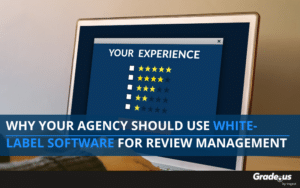Your clients are in pain.
Their business has specific challenges that keep them from achieving the results they desperately need. Challenges your agency is uniquely equipped to handle.
These pain points can be damaging.
These challenges have the potential to undermine every facet of your client's marketing. It makes their advertising more expensive. It decreases their conversion rates, making it harder to win new customers. It slowly erodes their profit margins.
Reviews make your client's pain points worse only if they're ignored
A review portfolio that's filled with negative reviews, has no reviews or is simply focused on a single platform (e.g. Google, Facebook, Yelp) aggravates client pain points.
Why?
Your client's customers want validation, that's why. They're looking for the social proof that answers their most pressing question. "Are you trustworthy and able to fix my problem?"
Online reviews answer that question.
Your client's reviews let their customers know:
1. They can fix their problem
2. They can be trusted to keep their word
3. It's safe for them to take a risk with your client
4. Your clients will absorb most of the risk
5. Other customers are happy/satisfied with your client's product or service
6. They'll receive the care, guidance and protection they'll need
A solid review portfolio answers these questions. Which is exactly why your clients need you to understand their pain points.
Do you know your client's pain points?
These paint points aren't as obvious as it seems.
In fact, your client's pain points tend to vary at different stages of the agency/client relationship. These pain points evolve, changing as clients gain a mature understanding of the process and what's expected of them.
This isn't always a good thing.
That's because many agencies aren't (a.) aware of their client's pain points at each stage (b.) they're unaware that clients themselves don't know what they want or what to expect (or they have the wrong expectations) and (c.) these pain points aren't dealt with ahead of time.
Which means you'll need to understand the pain points and various stages in the agency/client relationship.
Okay... What are they?
1. Pre-client pain points.
The agency/client relationship is just beginning. It's typically motivated by fear and frustration. A client comes to your agency in a panic. They're afraid and/or frustrated with the results (or lack thereof) of their campaign.
- They’re hit with a flood of negative reviews and no crisis management plan in place
- Sales and revenue is falling, your client can’t seem to figure out why
- Your client’s product or service is better but their customers aren’t buying
- Client lead costs are high and they continue to climb
- Clients want more/better reviews
At this point in the relationship, it's likely that clients haven't connected these problems to their reviews. Most clients do their best to fix the problem, but it's really more of the same. When they arrive at your agency it's because...
- They’ve made the connection between these pain points and their review portfolio
- You’ve made the connection for them, identifying the root cause of their pain points
If your client has already made the connection between their pain points and their online review portfolio your work gets easier. You'll be able to jump right in and get to work.
What if you've made the connection for them?
You'll need to do some more legwork. These clients, depending on where they are in the buyer's journey, need more education and handholding. More than your sophisticated clients who've already put two and two together.
2. Active client pain points.
Clients have finally signed on the dotted line. It's now time to get to work. It's common for active clients in this stage to experience anxiety and loss. They're in the process of adjusting their desires, goals and expectations or they're dealing with fear, anxiety and loss.
- Results take longer (than expected) to achieve
- Pre-client pain points may linger as the agency works to fix initial problems
- Agency clients invest money but they’ll also need to invest their time, and resources (e.g. connections, access, etc.), helping to solve their pain points
- The work is more involved/harder than expected
- Clients will need training to integrate marketing, customer service, and other departments into their review management campaigns
How agencies handle these pre-client and active client pain points determine whether they'll retain clients in the long term. If these expectations are managed well, clients are far more likely to stay.
What if they're not?
What if agencies do their part but clients are unwilling to push through?
3. Post client pain points.
It's inevitable.
Some of your clients will leave you. These pain points aren't necessarily about a failure on your part. Sometimes it's simply about the inability to justify or quantify the results you've already achieved.
- Clients didn’t see results from online review management (ORM)
- Clients didn’t get what they wanted from their ORM campaigns
- Agencies aren’t able to quantify the ROI of ORM
- Clients don’t have an attribution model so they can’t determine who gets credit for what
Here's the real problem.
Managing expectations. Clients arrive with fuzzy, implicit and unrealistic expectations. As we've seen, they have specific pre-client problems that demand attention.
If you're an agency, it's important that you run the show.
Here's why.
Clients typically don't tell you about their fuzzy, implicit and unrealistic expectations. They simply assume you already know about them. If you want to keep your clients, you'll need to flush these expectations out ahead of time.
· Fuzzy expectations. "I don't know what I want or expect but I want you to give it to me." These are expectations your clients can't explain to you but claim they'll immediately recognize once "you've figured it out."
· Implicit expectations. The details your client believes to be "obvious" or "self-evident" when they're anything but. It's all the general, yet unspoken, assumptions a client makes when there's familiarity with you.
· Unrealistic expectations. The expectations you're either unable or unwilling to meet for clients. Here's the dangerous part about unrealistic expectations. They can also be fuzzy or precise, implicit or explicit.
These expectations create a significant amount of fallout. Want to avoid that with future clients?
Find them.
Identify the expectations you're dealing with specifically. They come from one of four places (1.) word-of-mouth (2.) past experiences (3.) marketing content and (4.) personal desires/needs.
Why do these pain points matter?
Your client's pain points are tied to emotion
Researchers at Carnegie Mellon made an interesting discovery.
Your emotions change your perception of risk. Fear creates an aversion to risk. When we're afraid we're far less likely to take risks. Which is often what we need to do.
- Fearful clients are far more conservative in their approach
- Their goals are geared towards minimizing suffering rather than maximizing success
- They want you to make the pain stop. The sooner the better
- Clients are more likely to prefer a prudent ORM strategy in the beginning
What about when clients are angry or happy? They're far more optimistic and are much more willing to take risks. Which means...
- Clients are willing to spend more money on aggressive strategies and tactics
- Clients are still geared towards loss aversion, only now they’re focused on retaining the value you’ve provided
- Agencies that have achieved success are expected to hold and carry, achieve and retain
- Clients are open to aggressive strategies and tactics, provided that they don’t lose previous gains
Can you see what's happening?
Your client's biggest pain points need to be solved at two distinct levels.
1. The mesa level: The physical realm where your work and client interaction is done. Your agency creates an ORM campaign that boosts your client's conversion rate, increases revenue and drives 58 percent more sales.
2. The meta level: The abstract and intangible realm where what a client thinks, feels and believes about the work you've done is just as important as the mesa level, what you've done/can/will do.
Most agencies focus on the "mesa level" exclusively. They produce amazing results for their clients. But they fail to communicate at both the mesa and meta levels. As a result, clients eventually move on.
You need both.
Reviews relieve your client's pain points
Your client needs help.
Their business is faced with significant challenges. Struggles that keep them from achieving the results they need.
They come to you with fear.
Their challenges have the potential to undermine every facet of their business. Their struggles increase their expenses year-over-year. Their marketing and advertising costs continue to rise. Their conversion rates continue to fall. Their pain points eat away at their profit margins.
It's harder for them to win new customers.
Your clients want validation. They're looking for the social proof that answers their most pressing question. "Are you trustworthy and able to fix my problem?"
Reassure your clients.
Show them your answers to their questions. Your client's pain points change as the agency/client relationship evolves. Change with your clients, and you'll find you have everything you need to address their biggest pain points.
About the Author
Andrew McDermott
Andrew McDermott is the co-founder of HooktoWin. He shows entrepreneurs how to attract and win new customers.









